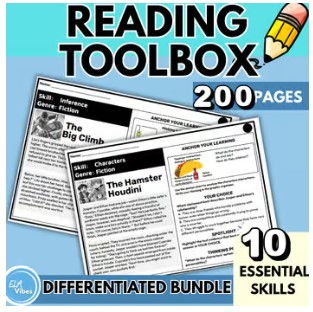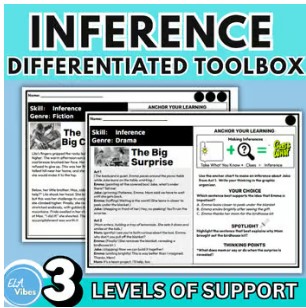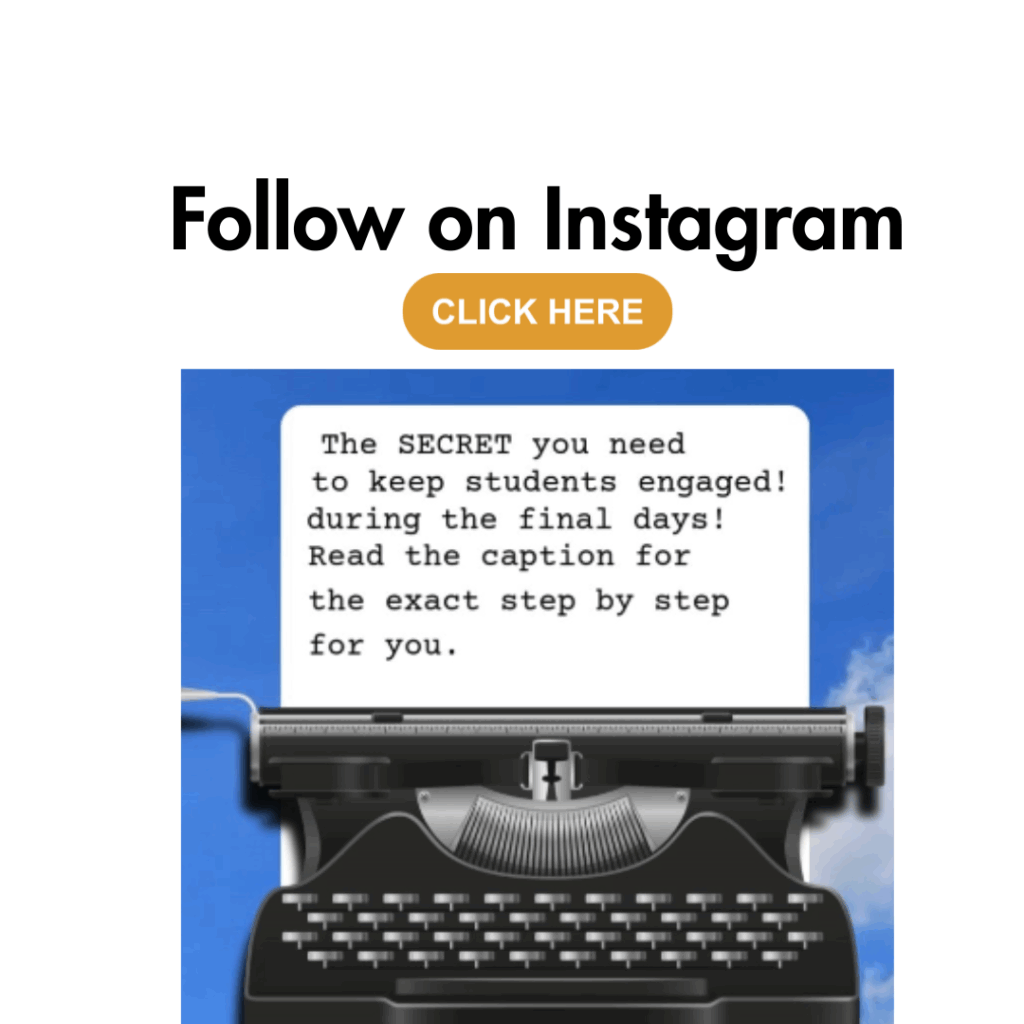Last updated on May 26th, 2025 at 10:13 pm

Let’s visualize differentiated reading instruction. You have 20 students in your grade-level reading class—but here’s the reality: 5 are still learning to decode, 4 have individualized learning plans, 7 are right on grade level, and 4 are identified as gifted and talented. The challenge? Meeting all those needs without without feeling like you need to be in five places at once. This post provides a clear path for differentiated reading instruction for 3rd, 4th, and 5th grade using low-prep, high-impact strategies.
What You’ll Learn About Differentiated Reading
- Define what differentiation means in reading
- Understand how to differentiate instruction in 3rd, 4th, 5th grade
- Apply the 3 elements of differentiated instruction to your reading block
- Explore examples of differentiated reading lessons for upper elementary
- Discover Grab and Go Differentiation Resources
What Does Differentiation Mean in Reading for 3rd–5th Graders?
Differentiated instruction is a fancy word that simply means different supports. I did not say different lesson plans. You can exhale now. Differentiated reading for 3rd 4th 5th graders sounds good in theory until you’re trying to juggle reading groups, data, accommodations, and fast finishers all at once. In my 4th grade ELA class, I was driving myself crazy with ten different lesson plans and activities because I thought every student needed a different plan to be successful. All I have ever heard was meet your students where they are at, but no one explained how to actually find the starting place and next steps. I pivoted and started building a system for differentiated reading instruction that included tiered tools, strategic supports, and meaningful choices.
Differentiation Is Not…
- A different lesson for every child
- Just giving advanced students “extra” work
- Reserved for students with IEPs
Differentiation Is…
- Thoughtful, proactive planning
- Flexible grouping and targeted strategies
- Meeting the same learning goal through different means
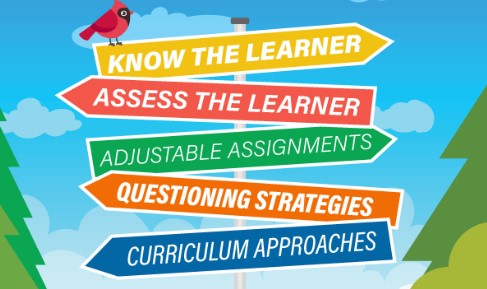
Why Differentiated Reading Instruction Matters in Upper Elementary
Differentiation is tailoring instruction to meet individual learning needs. I want you to take a step back and reframe your mind. Shift from pushing everyone through the same lesson to focusing on how students engage with the content, how they process it, and how they show understanding.
I am about to step on some toes. Be ready! If you teach 3rd, 4th, or 5th grade ELA, you’re expected to differentiate on grade-level material. Cue the record scratch. Wait! What? You may be thinking I have students who can’t even read! How are they going to access grade-level content? Before you click out of this post, stay with me.
The goal is for students to master grade-level standards. You know I love my analogies, so here we go.
Differentiation is Like a Taco Bar 🌮
Everyone is served the same main course: tacos (or known as grade-level content). How they build it is customizable.
- One student loads up on spicy salsa (above level students).
- Another needs a mild version with fewer toppings (on level students).
- A few may need help unwrapping the shell (below level students).
Why it matters: Every student gets access to the same “meal,” but how they consume it depends on what helps them succeed and nobody leaves hungry for learning.
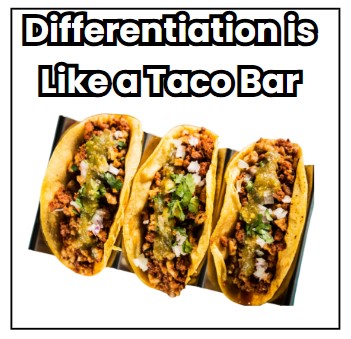
Meeting the Needs of Diverse Learners
Let’s revisit the definition. Differentiated reading instruction for 3rd, 4th, and 5th grade involves changing one or more of the following elements based on student need:
The 3 Elements of Differentiated Instruction:
- Content: What the student is given to learn
- Process: How the student engages with the content
- Product: How the student demonstrates understanding
Grab your free 3-level differentiated toolkit for inference.
Examples of Differentiated Reading Lessons in 3rd–5th Grade
Let’s break down how the comprehension skill of inference fits into each of the three elements of differentiated instruction. Assume you have given a pre-test or screener and know your students’ ability level.
The grade-level instruction includes students making inferences and using evidence to support understanding using the mentor text The Stranger by Chris Van Allsburg.
Need a ready to teach lesson? In my inference mini lesson, I break this down with built-in supports so every student can access the standard—whether they need sentence stems, visual cues, or open-ended challenge questions. Click the image that follows to grab the differentiated inference toolkit.
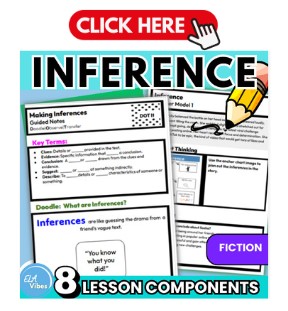
Content Differentiation
Content differentiation refers to “what” students are receiving to learn. Let’s circle back to inference. Everyone starts with the same mentor text and whole-group lesson. The independent task? Making inferences using a grade-level passage. The learning goal stays the same, but the supports are different. You’re adjusting the input not the standard, but how students access the material. What does this look like in the classroom?
Below level: These are students who have not mastered foundational skills. The following are 3 options to differentiate.
- Use the Read & Write Google Chrome extension to allow the text to be read aloud to them.
- Box in specific paragraphs to chunk the information to allow for more processing time.
- Allow students to look up images of unfamiliar words using an iPad or computer.
Same assignment, Same learning objective, Different entry point.
On Grade Level: These are students that show readiness for the grade level skill. The following are 3 options to differentiate.
- Provide an anchor chart to use as a reference.
- Have students use map colors to put questions in the margins for active reading.
- Encourage partner error analysis discussion using the following sentence stem. “Answer _ is incorrect because the text states _.
Same assignment, Same learning objective, Different entry point.
Above Grade Level: These are students that show readiness for advanced skills. The following are 3 options to differentiate.
- Use Bloom’s Taxonomy to deepen thinking skills. For example, students are defending their answers to a peer.
- Allow students to research a related topic and create a poster to share new insights.
- Assign a complementary topic and challenge them to write a new short passage and create 3 inference-based questions of their own.
Same assignment, Same learning objective, Different entry point.
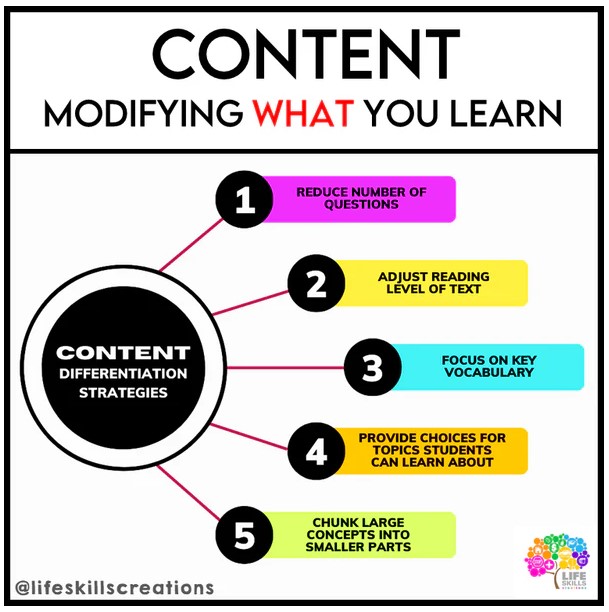
Process Differentiation
Process differentiation is “how” students are learning. Once again, everyone starts with the same mentor text and whole-group lesson. You adjust the how—not the what, but how students are learning the skill. What does this look like in the classroom?
Below level: These are students who have not mastered foundational skills. The following are 3 options to differentiate.
1. Use sentence frames: “I can infer___ because ___.”
2. Partner read with discussion after each chunk.
3. Highlight text clues together for visual supports.
On Grade Level: These are students that show readiness for the grade level skill. The following are 3 options to differentiate.
- Use a 3-column inference organizer (Clue / What I Know / Inference).
- Independent reading with sticky note jots.
- Peer text talks with guided prompts.
Above Grade Level: These are students that show readiness for advanced skills. The following are 3 options to differentiate.
- Infer and defend two possible interpretations
- Create a character thought map
- Lead a small group “What’s missing?” discussion

Product Differentiation
Product differentiation is how students “show” their learning. You adjust the final demonstration. What does this look like in the classroom?
Below level: These are students who have not mastered foundational skills. The following are 3 options to differentiate.
- Match text clues to character emojis.
- Draw a picture and label the inferred feeling.
- Verbally explain an inference with sentence support.
On Grade Level: These are students that show readiness for the grade level skill. The following are 3 options to differentiate.
- Write a short-response inference with text evidence.
- Complete a STAAR-style multiple choice with justification box.
- Create a comic strip showing a moment that requires inference.
Above Grade Level: These are students that show readiness for advanced skill. The following are 3 options to differentiate.
- Write a diary entry in a character’s voice showing hidden emotions.
- Compare two characters’ inferred traits with evidence.
- Create an alternate ending that shows a character’s true motives.

Conclusion
Differentiated reading instruction doesn’t mean more work—it means different supports.
Ready to simplify it even more? Grab the Reading Strategy Differentiation Toolkit—low-prep, leveled, and classroom-tested. Click on the image that follows for more information. ⬇️⬇️
